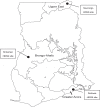Determinants of attending antenatal care at least four times in rural Ghana: analysis of a cross-sectional survey
- PMID: 28578634
- PMCID: PMC5496066
- DOI: 10.1080/16549716.2017.1291879
Determinants of attending antenatal care at least four times in rural Ghana: analysis of a cross-sectional survey
Abstract
Background: Improving maternal health is a global challenge. In Ghana, maternal morbidity and mortality rates remain high, particularly in rural areas. Antenatal care (ANC) attendance is known to improve maternal health. However, few studies have updated current knowledge regarding determinants of ANC attendance.
Objective: This study examined factors associated with ANC attendance in predominantly rural Ghana.
Methods: We conducted a cross-sectional study at three sites (i.e. Navrongo, Kintampo, and Dodowa) in Ghana between August and September 2013. We selected 1500 women who had delivered within the two years preceding the survey (500 from each site) using two-stage random sampling. Data concerning 1497 women's sociodemographic characteristics and antenatal care attendance were collected and analyzed, and factors associated with attending ANC at least four times were identified using logistic regression analysis.
Results: Of the 1497 participants, 86% reported attending ANC at least four times, which was positively associated with possession of national health insurance (AOR 1.64, 95% CI: 1.14-2.38) and having a partner with a high educational level (AOR 1.64, 95% CI: 1.02-2.64) and negatively associated with being single (AOR 0.39, 95% CI: 0.22-0.69) and cohabiting (AOR 0.57, 95% CI: 0.34-0.97). In site-specific analyses, factors associated with ANC attendance included marital status in Navrongo; marital status, possession of national health insurance, partners' educational level, and wealth in Kintampo; and preferred pregnancy timing in Dodowa. In the youngest, least educated, and poorest women and women whose partners were uneducated, those with health insurance were more likely to report at least four ANC attendances relative to those who did not have insurance.
Conclusions: Ghanaian women with low socioeconomic status were less likely to report at least four ANC attendances during pregnancy if they did not possess health insurance. The national health insurance scheme should include a higher number of deprived women in predominantly rural communities.
Keywords: Ghana; Maternal mortality; antenatal care; determinants; women service utilization.
Conflict of interest statement
No potential conflict of interest was reported by the authors.
Figures
References
-
- World Health Organization Trends in maternal mortality: 1990 to 2015. WHO. [cited 2016. May 13]. Available from: www.who.int/reproductivehealth/…/maternal-mortality-2015/en/http://www.w...
-
- Ghana Statistical Service, Ghana Health Service, and ICF Macro Ghana demographic and health survey 2014 Key Indicators. Accra, Ghana; 2015. April Available from: http://www.statsghana.gov.gh/docfiles/DHS_Report/Ghana_DHS_2014-KIR-21_M...
-
- World Health Organization, United Nations Population Fund, United Nations International Children’s Emergency Fund, The World Bank. Pregnancy, childbirth, postpartum and newborn care: a guide for essential practice (3rd edition). World Health Organization. [cited 2016. July 13]. Available from: http://www.who.int/maternal_child_adolescent/documents/924159084x/en/
-
- Magadi MA, Madise NJ, Rodrigues RN. Rodrigues RN: frequency and timing of antenatal care in Kenya: explaining the variations between women of different communities. Soc Sci Med. 2000;51:551–11. - PubMed
MeSH terms
LinkOut - more resources
Full Text Sources
Other Literature Sources
Medical

